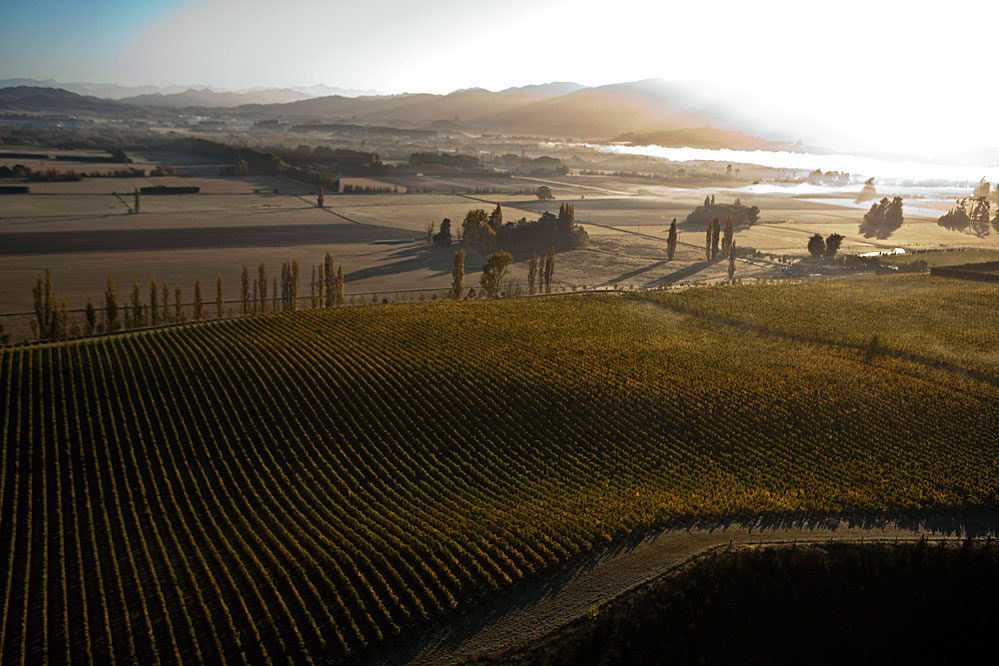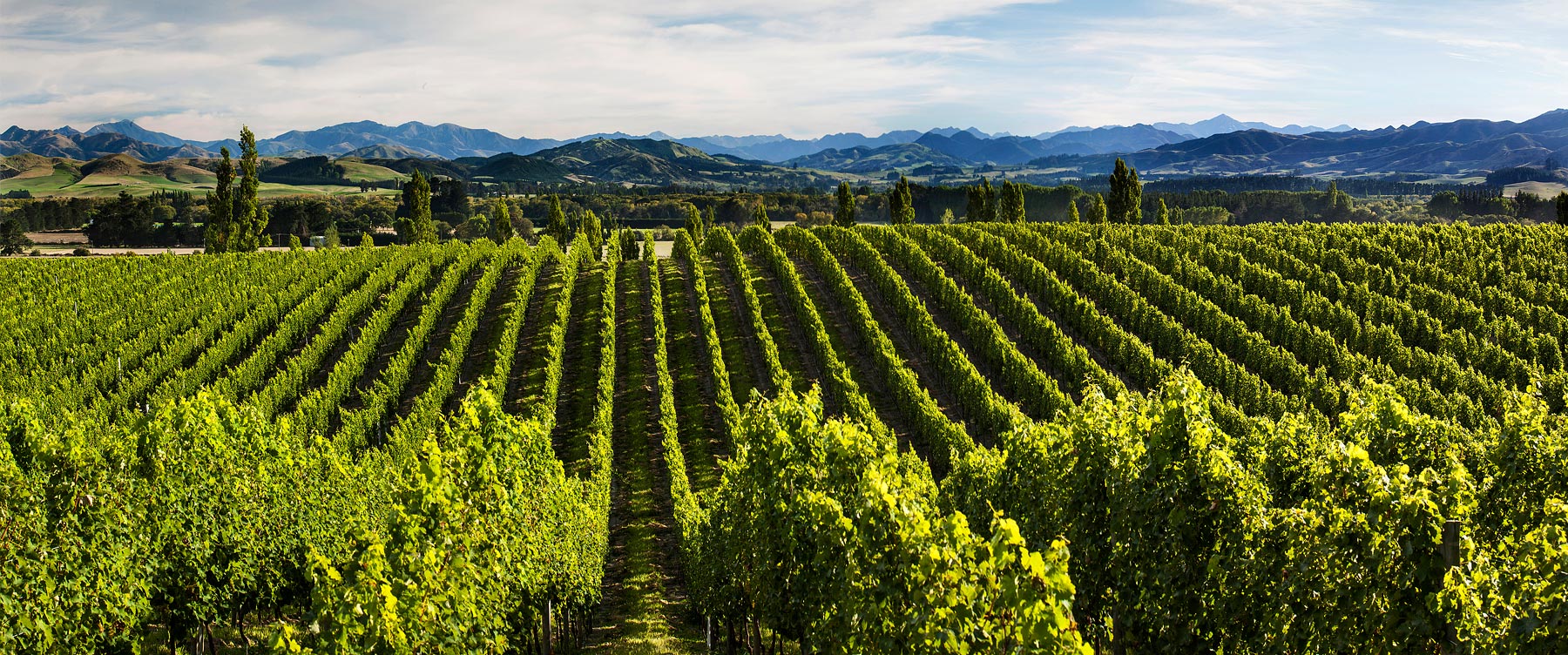Our Place
Our Place
Mt. Beautiful lies in the heart of North Canterbury, on the South Island of New Zealand. The Kaikoura Seaward Mountains lie to the North, while the Waiau River borders us to the North as well. The vineyard rests under its namesake, Mt. Beautiful. Mt. Beautiful crowns the coastal range to the East, and protects the vineyards from the ocean winds. Located about an hour and a half north of Christchurch on Route 1, Mt. Beautiful Winery is on the Northern fringe of the North Canterbury growing region. Lauded by many critics as New Zealand's most underestimated wine region, it's a place that has begun to get some incredible recognition. "'North Canterbury is the centre of 'the finest Pinot Noir' in the southern hemisphere, according to wine critic Matthew Jukes," as quoted in Decanter Magazine. John Bartlett of the New Zealand Wine Directory notes that "There are many wineries making wine in the region," and “all have their own individual character, as the range of soils and weather varies across North Canterbury. Many of the winemakers in the region are exploring different ways of producing ‘savvy’ and the resultant wines are quite unique and very interesting.” Mt. Beautiful's wines are a stunning representation of the splendor of the region. The Sauvignon Blanc reaches through the herbaceous spectrum to carry flavours of tropical fruits, the Riesling is ripe with mandarin and citrus, the Pinot Gris is lush and exhibits a creamy mid palate, the Pinot Noir is soft, juicy, and inviting with a hint of cherry, and the Chardonnay is bursting with aromatics of ripe apple and stone fruits while finishing with a clean and crisp flint like minerality. Mt. Beautiful's wines are a stunning representation of the splendor of the region. The Sauvignon Blanc reaches through the herbaceous spectrum to carry flavors of tropical fruits; the Riesling is ripe with mandarin and citrus; the Pinot Gris is lush and exhibits a creamy mid palate; and the Pinot Noir is soft, juicy, and inviting with a hint of cherry.

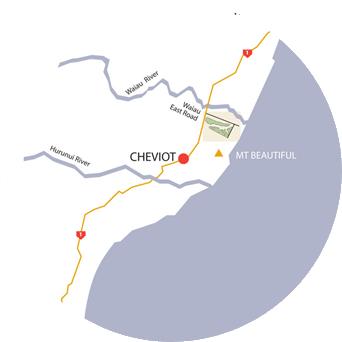
Our Vineyard
Our Vineyard
- Overview
- Sauvignon Blanc
- Pinot Noir
- Pinot Gris
- Riesling
- Chardonnay
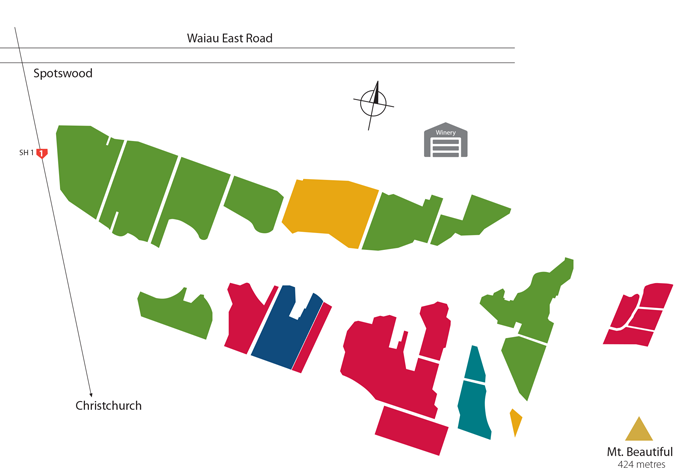
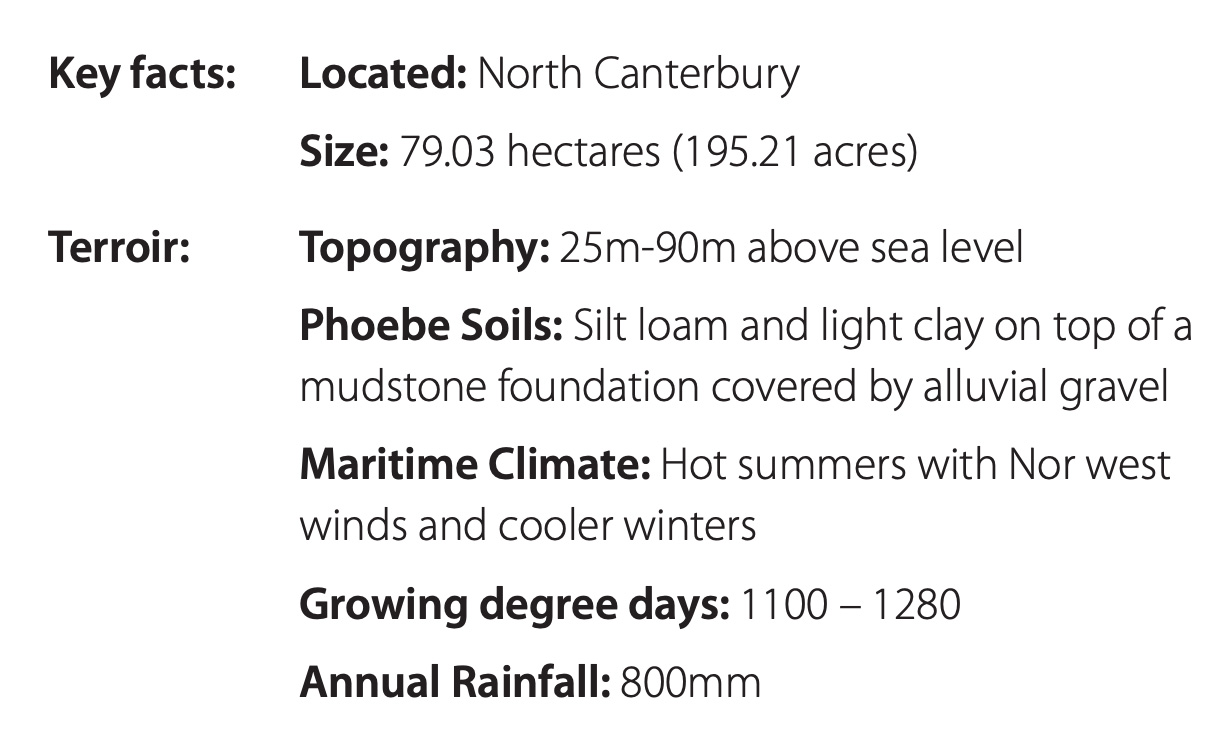
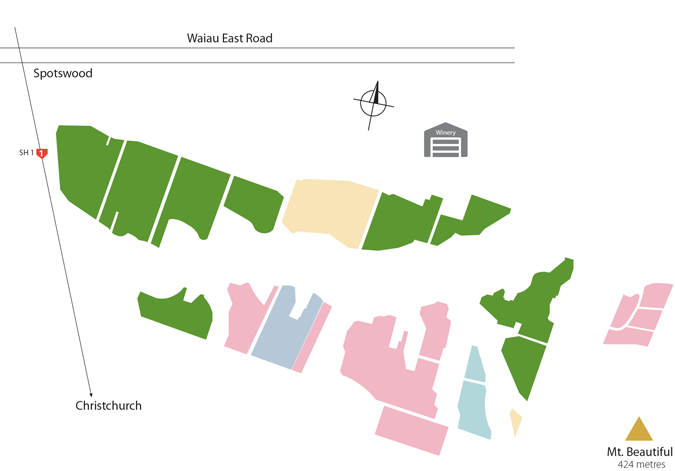
Planted 2004-2006
9 blocks
38.0 ha (93.9 ac)
Yield: 8 T/ha (3.23 T/ac)
101,497 vines
Spacing: @2.4 x 1.5 m
Sauvignon Blanc
Flavour Profile:
Our Sauvignon Blanc pushes the boundaries of the typical New Zealand flavour profile. By highlighting floral aromatics and tropical flavours such as guava and melon-like fruit, we tone down the grassiness and bring a creamy mid-palate all the way through to a fresh and bright crispness on the finish. We have set a new precedent for New Zealand Sauvignon Blanc.
For the Aficionado:
The majority of the Sauvignon Blanc is planted on the most northern part of the vineyard which is cooler and more suited to this variety. All of our Sauvignon Blanc is hand-thinned and machine harvested before it is pressed into juice on site. The planted clones are a mix of University of California Davis (UCD) 1 and Mass selection (MS) on a mix of 101-14, 3309 and Schwarzmann rootstock, with a quarter of the vines Bordeaux clones BDX 316 and BDX 317, on Riparia Gloire rootstock. The Bordeaux clones tend to give a definite lift to Sauvignon Blanc flavours, with less cut grass and more tropical flavours providing a more artisan style, balanced, elegant wine which compliments a range of foods.
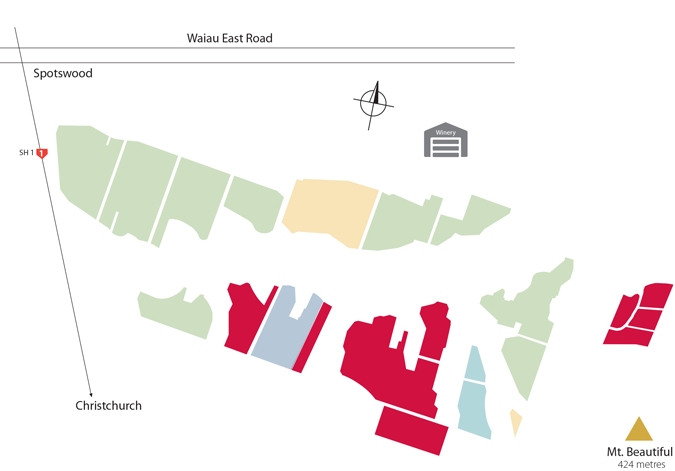
Planted 2004-2019
9 blocks
27.7 ha (68.5 ac)
Yield: 6T/ha (2.5 T/ac)
98,572 vines
Spacing: @2.2 x 1.0 m
Pinot Noir
Mt. Beautiful Pinot Noir
Flavour Profile:
As a personal favourite of Mt. Beautiful’s owner David Teece, it’s incredibly important for our Pinot Noir to showcase the best aspects of the varietal. Subtlety is the secret inside this wine. It begins with sophisticated floral fragrances of sweet spice and ripe soft red berry fruits, while showcasing an elegant medium-weight palate that features fragrant strawberry and bramble fruit, earthiness and subtle tannins.
For the Aficionado:
Our mix of Pinot Noir clones were specifically chosen for their flavour profile with 50% of the vineyard planted in Burgundy clones. Clone BDX 667 fills out the middle palate, while BDX 777 provides a long finish. The rest of the vines are a mixture of seven other clones, including UCD 5, UCD 6, 114 and 115. The aim of these selections is to build sound palate structure in the wine, providing a vibrant ruby wine with ripe fruit, subtle tannins, great length and persistence of flavour.
Mt. Beautiful 10 Barrels Select Pinot Noir
Flavour Profile:
Our first ever Barrel Select Pinot Noir begins with sophisticated floral fragrances of violets and blackberries, underpinned by subtle power and savoury bacon-like aromas. On the palate this elegant wine reveals a veiled depth of intense bramble-like fruit, earthiness and subtle chalky tannins that run right through the mouth. The wine finishes with an echo of that toasty crisp bacon fat, and with a clarity of fruit and good persistent flavour.
For the Aficionado:
Our Barrel Select Pinot Noir comes from M Block West and M Block Gully.
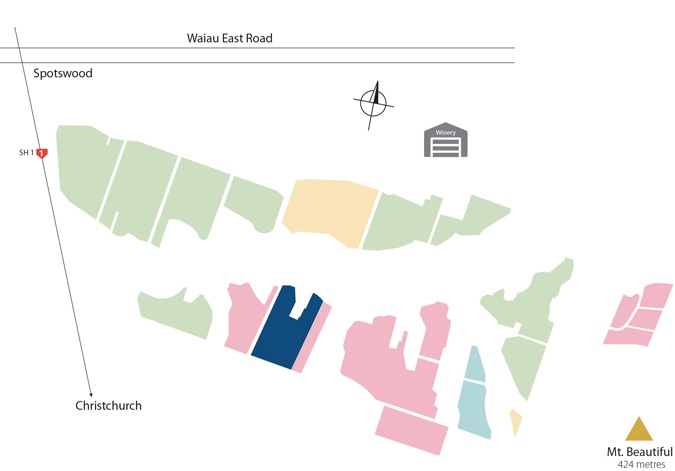
Planted 2005-2006
1 block
4.3 ha (10.6 ac)
Yield: 8 T/ha (3.24 T/ac)
11,733 vines
Spacing: @2.4x1.5 m
Pinot Gris
Flavour Profile:
Our Pinot Gris is an invitation to experience the unexpected. Aromatically the wine is floral with a nutty undertone featuring scents of quince blossom and hazelnuts. On the palate, it’s dry and full-bodied, warm and ripe with luscious ripe Nashi pear flavours backed by sensuous texture. It has a cream-like finish; clean with a crisp citrus twist at the end.
For the Aficionado:
The Pinot Gris is planted on the warm slopes of a north facing hill block of natural un-contoured land, sloping from 55m to 32m above sea level. This site is well suited for Pinot Gris as it is out of the cooler and lower surrounding areas and the soil mix of silt loam and clay provide excellent water holding properties. It is all hand tended throughout the season and at harvest. A variety of Pinot Gris clones have been planted including, German Geisenheim clone 2/21, new clonal reselections from South Africa, e.g. clones 7a, 14a and 52b and the Berrysmith clone, which provides a full bodied, textural wine with a richness in the mid palate.
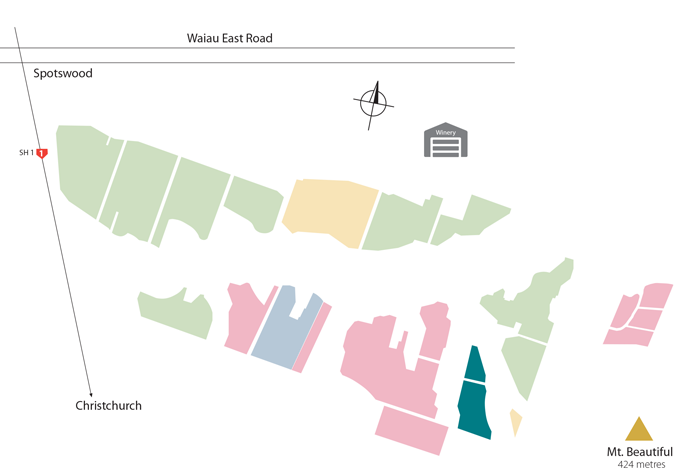
Planted 2005
2 blocks
2.63 ha (6.5 ac)
Yield: 7 T/ha (2.8 T/ac)
10,570 vines
Spacing: @2.4 x1.05 m
Riesling
Flavour Profile:
The Riesling is our baby, in the sense that it was the first wine we produced and launched to the public. It is a purely textural adventure, ripe with off-dry flavours of honeysuckle, pink grapefruit and sweet almond blossom. The citrus notes meld together with crisp minerality and a complex ripe apple character. It finishes with a beautiful, lingering acidity. This wine is made by blending together two distinct blocks of Riesling from the vineyard.
For the Aficionado:
The Riesling is planted on the higher elevated Southern section of the vineyard bordered by gullies, with the gully to the west being an established pine forest creating a warm sheltered block. The Riesling is closely planted, and has been split into two blocks with the lower block being spur pruned and the higher larger block single cane pruned to reduce vigour and maximize flavour. Like several of our other blocks we tend and harvest this block by hand. These plantings focus on German Geisenheim clone Gm 239, backed by clones Gm 198 and then Gm 110, which provide a classically elegant wine with mandarin, lime and lemon flavours.
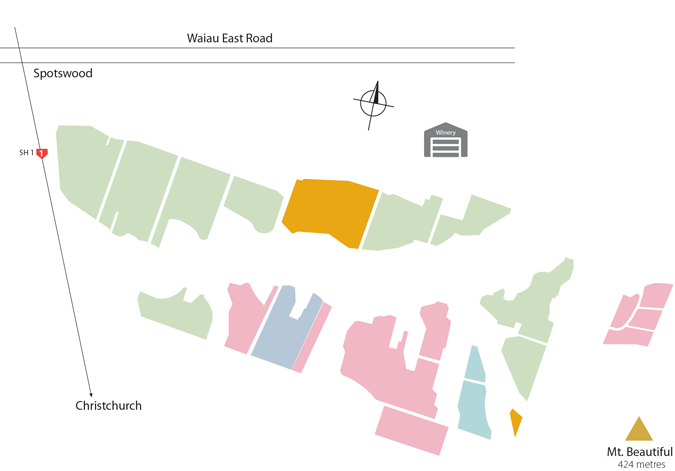
Planted 2006-2019
2 blocks
6.4 ha (15.8 ac)
Yield: 8T/ha (3.23 ac)
17,433 vines
Spacing :@2.4 x1.65 m
Chardonnay
Flavour Profile:
An aromatic Chardonnay displaying white peach and toasted brioche with a creamy texture that makes it easy to drink. It is a medium bodied wine with ripe nectarine-like fruit and underlying notes of roasted almonds and cinnamon. The wine boasts a clean and crisp finish, lovely persistent minerality and savory toastiness.
For the Aficionado:
Our Chardonnay is planted on the most Northern part of the vineyard and is hand-tended and hand-harvested. The clones are a mixture of French clones B95, 548, UCD15 and UCD1 grafted onto different rootstocks. The vineyard is in charge of dictating the flavour profile of the Chardonnay, so far yielding flavours of peachy stone fruits and creamy almonds. The first vintage was 2013.
CLICK HERE to download vineyard map PDF. The plantings are divided into 23 separate blocks, highlighting clonal selection, sun exposure, land aspect and soil composites. Surrounding the vineyard is our working sheep and beef farm covering 500 hectares. The two main hill slopes are dissected by a lake which divides the vineyard into North and South blocks. The Northern blocks are lower and cooler and more suited to our Sauvignon Blanc. The Southern blocks are higher and warmer, and suited to our Pinot Noir, Pinot Gris and Riesling varieties. The vineyard enjoys a cool maritime climate. Cool nights and warm days, accompanied by nor'westerly winds in the spring, combine with the mix of rich silt loam and clay soil to provide an ideal environment for nurturing our vines. We planted our first vines in 2004 and harvested our first grapes in 2007. By working with sustainable practices, we are working in harmony with the landscape and preserving the land for future generations. Our soils are Phoebe soils which are silt loam and light clay on top of a mudstone foundation which is covered by alluvial gravel. Mt. Beautiful Pinot Gris: Mt. Beautiful Chardonnay: Mt. Beautiful Riesling: Mt. Beautiful Pinot Noir:
![]() Our vineyard is 79 hectares or 195.21 acres
Our vineyard is 79 hectares or 195.21 acres![]() We experience 800mm or 31.5 inches of annual rainfall
We experience 800mm or 31.5 inches of annual rainfall![]() Our vineyard is located from 25m-90m or 80-295 feet above sea level
Our vineyard is located from 25m-90m or 80-295 feet above sea level![]() The actual Mt. Beautiful is 424 meters or 1392 feet elevation
The actual Mt. Beautiful is 424 meters or 1392 feet elevation![]() Cool maritime climate characterised by hot summers with Nor West winds and cooler winters
Cool maritime climate characterised by hot summers with Nor West winds and cooler winters![]() The Waiau River borders our vineyard to the North
The Waiau River borders our vineyard to the North
KEY VINEYARD FACTS
Located: North Canterbury
Vineyard Size: 79.0 hectares (195.21 acres)
Topography: From 25m-90m above sea level
Phoebe Soils: Silt loam and light clay on top of a mudstone foundation covered by alluvial gravel.
Maritime Climate: Hot summers with Nor west winds and cooler winters.
Growing Degree Days: between 1100 – 1280
Annual Rainfall: 800mm
Mt. Beautiful Sauvignon Blanc:
The majority of the Sauvignon Blanc is planted on the most northern part of the vineyard which is cooler and more suited to this variety. All of our Sauvignon Blanc is hand-thinned and machine harvested before it is pressed into juice on site. The planted clones are a mix of University of California Davis (UCD) 1 and Mass selection (MS) on a mix of 101-14, 3309 and Schwarzmann rootstock, with a quarter of the vines Bordeaux clones BDX 316 and BDX 317, on Riparia Gloire rootstock. The Bordeaux clones tend to give a definite lift to Sauvignon Blanc flavours, with less cut grass and more tropical flavours providing a more artisan style, balanced, elegant wine which complements a range of foods.
The Pinot Gris is planted on the warm slopes of a north facing hill block of natural un-contoured land, sloping from 55m to 32m above sea level. This site is well suited for Pinot Gris as it is out of the cooler and lower surrounding areas and the soil mix of silt loam and clay provide excellent water holding properties. It is all hand tended throughout the season and at harvest. A variety of Pinot Gris clones have been planted including, German Geisenheim clone 2/21, new clonal reselections from South Africa, e.g. clones 7a, 14a and 52b and the Berrysmith clone, which provides a full bodied, textural wine with a richness in the mid palate.
Our Chardonnay is planted on the most Northern part of the vineyard and is hand-tended and hand-harvested. The clones are a mixture of French clones B95, 548, UCD15 and UCD1 grafted onto different rootstocks. The vineyard is in charge of dictating the flavour profile of the Chardonnay, so far yielding flavours of peachy stone fruits and creamy almonds. The first vintage was 2013.
The Riesling is planted on the higher elevated Southern section of the vineyard bordered by gullies, with the gully to the west being an established pine forest creating a warm sheltered block. The Riesling is closely planted, and has been split into two blocks with the lower block being spur pruned and the higher larger block single cane pruned to reduce vigour and maximize flavour. Like several of our other blocks we tend and harvest this block by hand. These plantings focus on German Geisenheim clone Gm 239, backed by clones Gm 198 and then Gm 110, which provide a classically elegant wine with mandarin, lime and lemon flavours.
The Pinot Noir is planted on the Southern section, which has the highest elevation in the vineyard, providing extra warmth and less exposure to frost. In addition to this our Pinot Noir is closely planted to reduce vigour resulting in lower crop levels, allowing us to ripen these grapes to achieve a true expression of this variety. Our Pinot Noir is all hand tended throughout the season and at harvest. Our mix of Pinot Noir clones were specifically chosen for their flavour profile with 50% of the vineyard planted in Burgundy clones. Clone BDX 667 fills out the middle palate, while BDX 777 provides a long finish. The rest of the vines are a mixture of seven other clones, including UCD 5, UCD 6, 114 and 115. The aim of these selections is to build sound palate structure in the wine, providing a vibrant ruby wine with ripe fruit, subtle tannins, great length and persistence of flavour.
Our Viticulture
Our Viticulture
Two years of diligent research unearthed the plots of land that would be woven together to become Mt. Beautiful—and this patient search was well worth the effort. A world renowned business intellectual and proud New Zealand native, David Teece was on a mission to find a place—yet untouched by vines and “off the radar” of the wine industry—that possessed unique characteristics unlike any other vineyard site in New Zealand. Their purpose? To pioneer an undiscovered region and in the process build a winery that could serve as an inspiring global ambassador for New Zealand’s beauty and the quality of its products. A piece of history What David discovered was a hardscrabble piece of land in the South Island's North Canterbury region, located at the base of the Southern Alps, with the Seaward Kaikoura Range to the North and the Pacific Ocean seven miles to the East. It was in this very spot that William "Ready Money" Robinson bought a massive parcel, called "The Cheviot Estate," with a bag full of cash in 1856. This unusual exchange became known as the largest and most spectacular transaction of the kind ever undertaken in New Zealand. In 1893, however, the New Zealand government stepped in to divide this huge plot into smaller plots, which they sold off to encourage more small family farms in the region. The history of this singular location, and the desire to reconnect formerly disconnected parcels, might have been enough to inspire David to transform the land into vineyards. But this rugged outpost, with impressive views of the snow-covered Southern Alps also promised to be a thrilling vineyard site. Embracing the adventure, David purchased four farms between 2003-2004 and planted them to vines from 2003-2005. Pioneers take the arrows There were risks in putting down stakes in an untested parcel but the "knowns" were risky, too: powerful nor'westers that blow through unexpectedly (and stay for weeks at a time), scorching summers (with very little rainfall, if any) and winter frosts. It's a coarse and weather-beaten patch highlighted by deep chasms, flat spaces, slopes and hills—the kind of landscape that attracts pioneering types (now counting a globally-recognized economist among them). But the risks have paid off in spades. Discovering 23 different soil types was just the beginning. Mt. Beautiful had other advantages: an array of diverse microclimates ideal for planting a range of varietals; the 1392-foot Mt. Beautiful, which protects vines from blasts of seaward winds; and the temperature-balancing influences of two rivers, the Waiau (North) and Hurunui (South). The property features Phoebe soils: very deep, well-drained soils formed in glacial outwash mixed with volcanic ash and loess. In their research of every inch of the land, the team has also located a preponderance of limestone. Those looking to craft memorable Pinot Noir believe this is the holy grail of soil, known for its role in producing the great Burgundian wines. Careful Clone Selection The benefits of having different clones of a particular grape varietal are many, ranging from flavour, colour, bunch size, and berry size to tannins, phenolics, ability to grow and ripen, and susceptibility to diseases, drought, and frost. In consideration of the diverse microclimates and soil profiles of the vineyard, the team approached clone selection carefully. Today the vineyard features almost 30 selections with six in Pinot Gris, three in Chardonnay, four in Riesling, four in Sauvignon Blanc and over 10 clonal selections in just Pinot Noir plantings. Although Mt. Beautiful’s Sauvignon Blanc is its highest production wine (approximately 15,000 cases per year), the total Sauvignon Blanc volume produced from the Canterbury winegrowing region as a whole amounts to only 2% of that produced by its more renowned Marlborough neighbor. One of Mt. Beautiful’s commitments to developing North Canterbury as a respected winegrowing region is to produce wines that are distinctive from those produced in Marlborough. In doing so, they have planted a mix of clones that tend to give a definite lift to Sauvignon Blanc, with less cut grass and more tropical flavours providing a more artisan style, balanced, and elegant wine which compliments a range of foods. In addition to distinguishing their Sauvignon Blanc, the team at Mt. Beautiful is seizing the opportunity to create a unique flavour profile for their Pinot Noir, since there is no "New Zealand style" expectation for the variety. This also happens to be the second most heavily planted variety in the vineyard, representing 22 hectares (54.3 acres) and more than 90,000 vines. The Pinot Noir plantings feature a mix of clones specifically chosen for their flavour, with 50% of the vineyard planted in Burgundy clones. The aim of these selections is to build sound palate structure, providing a vibrant ruby-hued wine with ripe fruit, subtle tannins, great length and persistence of flavour. Commitment to sustainability Sustainable farming methods are a core value behind Mt. Beautiful's success; the vineyards and winery are certified-sustainable. In the vineyard, the team uses minimal input—they tread very carefully, using things like motorbikes to pull the mowers and harvesting by hand. Lush ground cover acts as host plants for parasitic wasps that naturally keep pests under control. Flowers and other plants attract beneficial insects in and around the grapevine rows. Additionally, after these helpful plants have flowered and served their purpose, their organic matter adds nutrients to the soil. With diverse growing conditions, highly coveted soil, meticulously nurtured vineyard and a brand new winery, Mt. Beautiful has embarked on a path many winemakers could only dream of. The result? Certified-sustainable, estate-grown wines that are the expression of this wild and rugged region, with distinctively restrained aromatic and flavour profiles that let the pure terroir come through.
